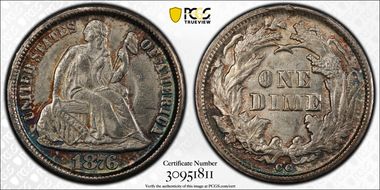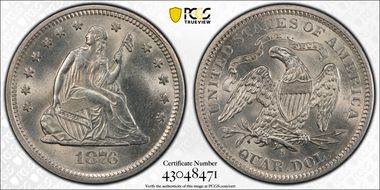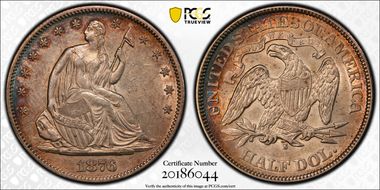Lena Kent (1876-1951) 的钱币相册
The 1876 Shield Nickel has a slighter higher mintage than the 1875, and is slightly less valuable in all grades, mostly due to higher populations. Like most of the common Shield Nickels, this date is seen most frequently in MS-64, can be found withtout too much difficulty in MS-65, becomes scarce to rare in MS-66, and is unobtainable finer. As usual, this date comes with some interesting die cracks. Look for coins that show intense luster and which are as free of spots as possible.
In 1876, employees at the Philadelphia Mint produced a near-record number of Dimes -- over 11 mllion, second only to the massive mintage of over 12 million in 1853. If all mints are considerd, 1876 was a banner year in which over 30 million Dimes flowed out of Philadelphia, San Francisco, and Carson City. This was a record production that far outstripped any previous year. According to Walter Breen, this reason for this extra production was to replace the 10C Fractional Currency notes still in circulation. As might be expected, the 1876-P Dime is a very common coin, and one which can be found with ease in top conditions. Gems, even up to MS66, are fairly plentiful (the PCGS CoinFacts Condition Census starts at MS66). In Superb condition (MS67 and better), the 1876 Dime becomes very rare. The finest example appears to be a single NGC MS67+, but the price record belongs to a PCGS MS67. In 1876, William Barber created a new hub, thus two different reverses appear on 1876 Dimes. On the old, Type 1 reverse, the ribbon on the left side of the reverse has a split end with two points; on the new, Type II reverse, the ribbon on the left side of the reverse comes to a single point.
With its large mintage of over 8.2 million pieces, the 1876-CC is the most common Dime from the Mint at Carson City. As such, it is plentiful in most grades, including all Mint State grades from MS60 to MS66. In 1876, William Barber created a new hub, thus two different reverses appear on 1876 Dimes. On the old, Type 1 reverse, the ribbon on the left side of the reverse has a split end with two points; on the new, Type II reverse, the ribbon on the left side of the reverse comes to a single point. For the 1876-CC Dime, there is a huge disparity between the Type I and Type II reverses. Gerry Fortin has identified 35 different die varieties among the Type I reverses, but only a single die variety comprises all of the Type II reverses. Beware -- Fortin presents two 101 varieties for this date -- one for each of the reverse types. There's a big difference in value between the Type I F-101 and the Type II F-101 (the Type II version is twice as rare as the Type I).
The 1876-S Quarter Dollar has one of the higher certified populations of the Seated Liberty series. This date is plentiful in MS63 and MS64, and can even be found with patience in MS65. In MS66, this date is very rare and none have been certified finer by PCGS. High-grade examples will have a nice "look" and most will sport a strong strike and rich, frosty luster. This date is an exceptional value for type purposes.
1876 saw a high-water mark set for production of Half Dollars -- 8,418,000 coins to be exact. No U.S. Mint in any location had ever poduced that many Half Dollars since the inception of coinage in 1794, nor would that mark be met or exceeded until 1917. Thus, the 1876 Half Dollar is generally considered to be the most common and most affordable of all the Seated Liberty Half Dollars. Hundreds of them have been certiified by PCGS in Mint State, usually in grades from MS62 to MS64. Gems become a little scarce and anything above MS65 is highly desirable. Despite the large production of 1876 Half Dollars, quality did not suffer. Nonetheless, we recommend that collectors seek out fully struck examples for their collections.
1876-S Half Dollars were produced in large quantities (over 4.5 million pieces) and they are plentiful in most grades. Collectors have scores to choose from in Mint State and most of those are well-struck. Little did the Mint employees know in 1876 that their facility would soon be shutting down production of Half Dollars after 1880. However, they still had one more year of near-record production before their rest. For the quality-minded collector, it is very difficult to find an 1876-S Half Dollar better than MS65.

























